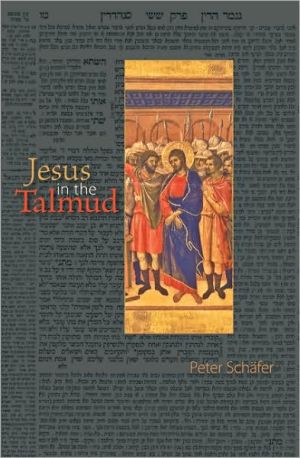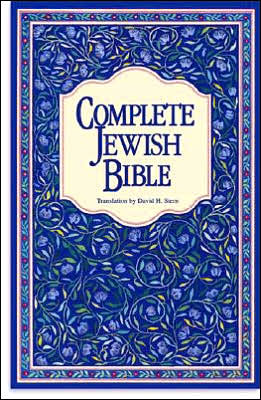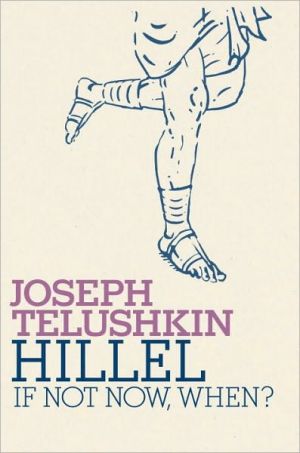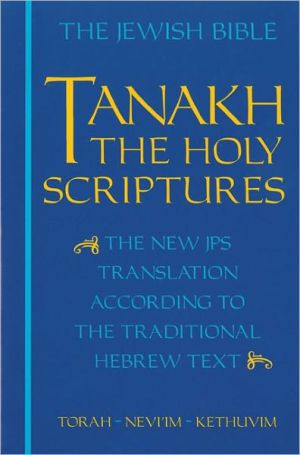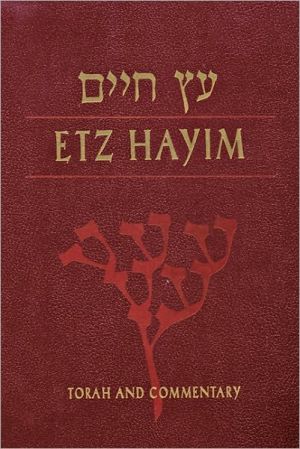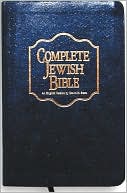Jesus in the Talmud
Scaterred throughout the Talmud, the founding document of rabbinic Judaism, are quite a few references to Jesus-and they're not flattering. In this richly detailed and accessible book, Peter Schäfer examines how the rabbis of late antiquity read, understood, and used the New Testament Jesus narrative to assert Judaism's superiority over Christianity.\ Though these stories are virulently anti-Christian-they mock Jesus' birth from a virgin, fervently contest his claim to be the Messiah, and...
Search in google:
"Peter Schäfer's remarkable volume on Jesus' enigmatic place in Talmudic literature is a work of erudition and depth. It will bring deeper knowledge to students and teachers of Judaism and Christianity."--Elie Wiesel"When the premiere 'Christian-Hebraist' of our era turns his attention to Jesus in the Talmud, everyone interested in ancient history and modern interreligious dialogue must take notice. Peter Schäfer carefully sifts through all of the literary evidence from that great monument of late-fifth-century Babylonian Jewish culture with fresh eyes and striking insights. His final chapter, focused on why the Babylonian Talmud could sustain such anti-Christian rhetoric, is a scholarly tour de force."--Rabbi Burton L. Visotzky, Jewish Theological Seminary"From the opening pages of Jesus in the Talmud the reader senses that something new and important is about to be unfolded. It is, and the unfolding of it is pure Schäfer: straightforward and plain-speaking, argued densely, yet with great clarity, provocative, but finally persuasive. And yes, exciting too."--F. E. Peters, author of The Children of Abraham"This is an exceptionally engaging book. Professor Schäfer has subjected to close scrutiny all the passages relating to Jesus in the Talmudic and other rabbinic literature produced in Palestine and in Babylonia in late antiquity. His aim is to use them to discover the rabbis' attitude to Christianity. While the force of the argument suggests this book should be mainly of interest to students of rabbinic Judaism, I believe that the subject matter will ensure that it has a much wider readership. It sheds light in places on the way the gospel traditions evolved particularly in Palestinian and Syriac-speaking Christianity."--Nicholas de Lange, University of Cambridge Ruth Langer - Studies in Christian-Jewish Relations Peter Schafer's Jesus in the Talmud reviews well-trodden territory but derives new and important readings from this familiar evidence. Applying contemporary historiographical methods, Schafer offers a convincing explanation of the talmudic texts about Jesus.
Jesus in the Talmud\ \ By Peter Schäfer \ Princeton University Press\ Copyright © 2006 Princeton University Press\ All right reserved.\ \ \ \ Introduction\ This book is about the perception of Jesus of Nazareth, the founder of Christianity, in the Talmud, the foundation document of rabbinic Judaism in Late Antiquity. What do these two-Jesus and the Talmud-have in common? The obvious answer is: not much. There is, on the one hand, the collection of writings called the New Testament, undisputedly our major source for Jesus' life, teaching, and death, most of it written in the second half of the first century C.E. And there is "the" Talmud, on the other, the most influential literary product of rabbinic Judaism, developed over several centuries in its two versions in Palestine and in Babylonia (the first, the Palestinian or Jerusalem Talmud, was edited in fifth-century Palestine, and the second, the Babylonian Talmud, reached its final form in the early seventh century in Babylonia). Both documents, the New Testament and the Talmud, could not be more different in form and content: the one, written in Greek, is concerned about the mission of this Jesus of Nazareth, who, regarded as the Messiah and the Son of God, was rejected in this claim by most of his fellow Jews, put to death by the Roman governor Pontius Pilate, and resurrected on the third day after his crucifixion and taken up into heaven; the other, written mostly in Aramaic, is a huge collection of mainly legal discussions that deal with the intricacies of a daily lifeconducted according to the rabbinic interpretations of Jewish law. \ Moreover, and here things become much more complicated, with the juxtaposition of "Jesus" and the "Talmud" bordering on an oxymoron, both stand in a highly charged and antagonistic relationship with each other. The Jewish sect triggered by Jesus in Palestine would eventually evolve into a religion of its own, a religion to boot that would claim to have superseded its mother religion and position itself as the new covenant against the old and outdated covenant of the people of Israel by birth. And at precisely the time when Christianity rose from modest beginnings to its first triumphs, the Talmud (or rather the two Talmudim) would become the defining document of those who refused to accept the new covenant, who so obstinately insisted on the fact that nothing had changed and that the old covenant was still valid.\ Yet strangely enough, the figure of Jesus does appear in the Talmud, as does his mother Mary-not in a coherent narrative, but scattered throughout the rabbinic literature in general and the Talmud in particular and often dealt with in passing, in conjunction with another subject pursued as the major theme. In fact, Jesus is mentioned in the Talmud so sparingly that in relation to the huge quantity of literary production culminating in the Talmud, the Jesus passages can be compared to the proverbial drop in the yam ha-talmud ("the ocean of the Talmud"). The earliest coherent narrative about Jesus' life from a Jewish viewpoint that we possess is the (in)famous polemical tract Toledot Yeshu ("History of Jesus"), which, however, took shape in Western Europe in the early Middle Ages, well beyond the period of our concern here (although, to be sure, some earlier versions may go back to Late Antiquity).\ So why bother? If the rabbis of rabbinic Judaism did not care much about Jesus, why should we care about the few details that they do transmit, apart from simply stating the fact that they did not care much? This is one possible approach, and, as we will see, the one that has been taken in the most recent research on our subject. But I do not think that it is an appropriate response to the problem posed by the admittedly meager evidence. First, the question of Jesus in the Talmud is, of course, part of the much larger question of whether and how the nascent Christian movement is reflected in the literary output of rabbinic Judaism. And here we are standing on much firmer ground: Jesus may not be directly mentioned, but Christianity, the movement that he set in motion, may well be discussed. Second, the starkly antagonistic paradigm of "Judaism" versus "Christianity," forever frozen, as it were, in splendid isolation from each other, has come under closer scrutiny over the past two decades. The overly simplistic black-and-white model of the one sister religion ("Christianity") emerging out of the other and almost simultaneously breaking off from it and choosing its own and independent path, and of the other ("Judaism"), remarkably unimpressed by this epoch-making event, steering its own course until being overcome by the historic momentum of the stronger "religion," no longer holds; the reality as it transpires from more detailed and unbiased research is much more complex and perplexing. Hence, no matter what the accumulation of quantitative evidence, we need to take very seriously any trace of a discourse between Judaism and Christianity, let alone of a reaction to Christianity's founder.\ As a matter of fact, some scholars have taken it exceptionally seriously. The history of research on how the Jews of Late Antiquity discussed Christianity in general and Jesus in particular is impressively rich and deserves a study of its own. It takes as its starting point the scattered rabbinic evidence about Jesus and Christianity in talmudic sources as well as the tract Toledot Yeshu, which was widely disseminated in the Middle Ages and the early modern period and became the major source for Jewish knowledge about Jesus. One of the first landmarks of a Christian examination of these Jewish sources, made increasingly accessible through Jewish converts, was the polemical treatise Pugio fidei ("The Dagger of Faith") composed by the Spanish Dominican friar Raymond Martini (d. 1285), which uses many extracts from talmudic and later rabbinic sources. It influenced most of the subsequent polemical, anti-Jewish pamphlets, particularly after the lost manuscript was rediscovered by the humanist scholar Justus Scaliger (d. 1609) and republished in 1651 (Paris) and 1678 (Leipzig). In 1681 the Christian Hebraist and polyhistorian Johann Christoph Wagenseil, a professor at the University of Altdorf in Germany, published his collection of Jewish anti-Christian polemics Tela ignea Satanae. Hoc est: arcani et horribiles Judaeorum adversus Christum Deum et Christianam religionem libri ("Flaming Arrows of Satan; that is, the secret and horrible books of the Jews against Christ, God, and the Christian religion"), also drawing on the talmudic literature and the Toledot Yeshu. The first book solely devoted to Jesus in the talmudic literature was the 1699 dissertation, submitted at the University of Altdorf by the Protestant Orientalist Rudolf Martin Meelführer, Jesus in Talmude ("Jesus in the Talmud"). Unlike Wagenseil, who was highly influential and widely read, his student Meelführer was almost immediately forgotten; both, however, were surpassed in their influence by Johann Andreas Eisenmenger's German work in two volumes, Entdecktes Judenthum ("Judaism Unmasked"), which would become-until well into the modern period-a major source for anti-Semitic attacks against the Jews.\ Whereas in the early modern period the "Jesus in the Talmud" paradigm served almost solely as an inexhaustible source for anti-Jewish sentiments, the subject gained more serious and critical recognition in the nineteenth and twentieth centuries. Among the extensive relevant literature a few authors deserve special attention: Samuel Krauss presented the first scholarly analysis of the Toledot Yeshu, based on an edition and comprehensive analysis of the variant versions of the text (1902), which even today remains the authoritative treatment of the subject. A year later, in 1903, Travers Herford published his Christianity in Talmud and Midrash, which would become the standard book about Christianity and Jesus in rabbinic sources, particularly in the English-speaking world. Herford's approach can be called maximalistic in every regard: not only are the many passages that mention the minim ("heretics" in the broadest sense of the term) dealing almost without exception with Christians, but he also concludes that almost all the passages in the rabbinic literature that have been remotely connected with Jesus and his life indeed refer to Jesus. The fact that he is rather restrained with regard to the value of the rabbinic sources as evidence for the attempt to reconstruct the historical Jesus does not detract from his generally maximalistic and quite naive approach.\ The first attempt to examine the relevant rabbinic passages about Jesus and Christianity critically and to provide a text critical edition and translation was made in 1910 by the Christian German scholar Hermann L. Strack (the same Strack who gained enormous reputation through his famous Introduction to the Talmud and Midrash) in his 1910 monograph Jesus, die Häretiker und die Christen nach den ältesten jüdischen Angaben. Strack set a sober tone, not only with regard to the historical value of the rabbinic evidence but also with regard to the number of the relevant passages, that was to become a major trend particularly in German-language research. The first major scholarly book on Jesus in Hebrew, published in 1922 by the Hebrew University professor Joseph Klausner, follows in its assessment of the Jesus passages a similar critical tendency: the evidence is scanty and does not contribute much to our knowledge of the historical Jesus; much of it is legendary and reflects the Jewish attempt to counter Christian claims and reproaches. The same is true for Morris Goldstein's Jesus in the Jewish Tradition of 1950 and a long (and rather convoluted) essay by Jacob Lauerbach, published in 1951.\ The climax of the latest development in the scholarly literature concerned with Jesus in the Talmud is Johann Maier's book of 1978, Jesus von Nazareth in der talmudischen Überlieferung. This is, in many respects, an amazing and disturbing book. It presents the most comprehensive, painstakingly erudite treatment of the subject so far. Maier has sifted through all the secondary literature, even if only remotely relevant, and showers the reader with excruciating details about who wrote what, and when. More important, all the rabbinic sources that have ever been brought into connection with Jesus are analyzed in every possible regard, with Maier taking great pains not just to discuss bits and pieces ripped out of context but to examine them always within the larger literary structure in which they are preserved. This is definitely a huge step forward in comparison with the rather atomistic efforts of his predecessors. But it is achieved at a high price. The reader who has followed Maier through all his endless and winding analyses, peppered with sophisticated charts, is left with the quite unsatisfying question: what is the purpose of all of this? For what Maier ultimately presents is an excess in scholarly acumen that leads nowhere or, to put a slightly more positive spin on it, that leads to the frustrating conclusion of "much ado about nothing." His book is the epitome of a minimalist exercise, just the opposite of Herford. According to Maier, there is hardly any passage left in the rabbinic literature that can be justifiably used as evidence of the Jesus of the New Testament. The rabbis did not care about Jesus, they did not know anything reliable about him, and what they might have alluded to is legendary at best and rubbish at worst-not worthy of any serious scholarly attention, at least after Maier has finally and successfully deconstructed the "evidence."\ To be sure, he does not say so in these words; in fact, it is rather difficult to determine what he really thinks about the results of his exercise. Clearly, he wants to position himself between or, more precisely, beyond the two alternatives of the anti-Jewish Christian and the apologetic Jewish approach. Whereas the former-charged with emotion-uses as its yardstick the theological truth of New Testament Christology, and finds everything that deviates from this "truth" appalling, the latter-painfully embarrassed by what their forefathers might have thought up-opts for a more restrained attitude and calls for moderation and distinction. Maier, naturally, dismisses the Christian anti-Jewish bias and finds the Jewish approach more appealing because he regards it altogether as more "critical" and "skeptical" and as capable-in what he regards as the epitome of modern critical scholarship-of distinguishing between the historical Jesus and the Jesus of the Christian faith. But he disapproves of its apologetic tendency to tone down the anti-Christian polemic in the Jewish sources, and he even lets himself be carried away in this context by the highly charged question: why shouldn't the Jews have allowed themselves to polemicize, since, after all, the holy Church Fathers and the Christian theologians did precisely this, over and over again, and with considerable political and social consequences? Indeed, why shouldn't they have? Maier's question should have become the starting point of a much deeper inquiry into the subject. But unfortunately, these and very few similar remarks are the only "emotional outbursts" that Maier grants himself. In general he remains the "objective" and "rational" scholar, who has overcome, with his literary deconstruction of the sources, Christian anti-Judaism and Jewish apologetics alike.\ Is this, then, the last word? Is there no other option beyond Christian anti-Judaism, Jewish apologetics, and Maier's almost "scientific" explaining away of the evidence? I strongly believe there is, and I intend to demonstrate that in the chapters of this book. Before we enter the detailed discussion of the relevant sources, I will set forth some of the principal considerations that will guide me through this discussion.\ Since this book is not aimed just at specialists, let me first clarify what I mean by discussing Jesus in the Talmud. By "Talmud" in the broadest sense of the term I mean the entire corpus of rabbinic literature, that is, the literature left to us by the rabbis, the self-appointed heroes of the Judaism of the classical period between the first and the seventh century C.E. This literature includes the Mishna and the Tosefta (the early twin collections of legal decisions, edited around 200 C.E. and in the third century respectively), the midrashim (the rabbinic commentaries on the Hebrew Bible in their manifold form), and-in the more narrowly defined and technical sense of the word-the Talmud in its two manifestations, the Jerusalem or Palestinian Talmud (edited in the rabbinic academies of Palestine in the fifth century) and the Babylonian Talmud (edited in the rabbinic academies of Babylonia in the seventh century C.E.). The later polemical tract Toledot Yeshu is not part of this investigation, although I do hope to turn to it in a follow-up project and, in addition to preparing a modern edition and translation, to clarify further its relationship with the talmudic evidence.\ I follow the traditional distinction between the earlier tannaitic sources (i.e., sources that are ascribed to the rabbis of the first and second centuries) and the later amoraic sources (i.e., sources that are ascribed to rabbis of the third through the sixth centuries) of the relevant talmudic literature. In addition, I put great emphasis on whether a certain tradition appears in Palestinian and Babylonian sources or solely in Babylonian sources, that is, in the Babylonian Talmud alone. Indeed, in calling the book Jesus in the Talmud I emphasize the highly significant role played by the Babylonian Talmud and Babylonian Jewry.\ The source material that I have chosen for analysis focuses on Jesus and his family. In other words, I am not claiming to deal with the much broader subject of how Christianity as such is reflected in the literature of rabbinic Judaism. One could argue that a book about "Jesus" in the Talmud cannot adequately be written without taking this broader context of "Christianity" into full consideration. To a certain extent I agree with such an approach (and sometimes I will venture into more comprehensive categories); yet I nevertheless take the risk of limiting myself to this more narrowly defined question because I believe that Jesus, along with his family, was indeed perceived in our sources as a subject of its own.\ Unlike Maier and many of his predecessors, I start with the deliberately naive assumption that the relevant sources do refer to the figure of Jesus unless proven otherwise. Hence, I put the heavier burden of proof on those who want to decline the validity of the Jesus passages. More precisely, I do not see any reason why the tannaitic Jesus ben Pantera/Pandera ("Jesus son of Pantera/Pandera") and Ben Stada ("son of Stada") passages should not refer to Jesus, and I will justify this claim in the book. Here I substantially disagree with Maier who vehemently denies the possibility that there are authentic tannaitic Jesus passages and even declares the amoraic passages as all belonging to the post-talmudic rather than to the talmudic period.\ (Continues...)\ \ \ \ \ Excerpted from Jesus in the Talmud by Peter Schäfer Copyright © 2006 by Princeton University Press . Excerpted by permission.\ All rights reserved. No part of this excerpt may be reproduced or reprinted without permission in writing from the publisher.\ Excerpts are provided by Dial-A-Book Inc. solely for the personal use of visitors to this web site. \ \
Acknowledgments ixAbbreviations xiiiIntroduction 11 Jesus' Family 152 The Son/Disciple Who Turned out Badly 253 The Frivolous Disciple 344 The Torah Teacher 415 Healing in the Name of Jesus 526 Jesus' Execution 637 Jesus' Disciples 758 Jesus' Punishment in Hell 829 Jesus in the Talmud 95Appendix: Bavli Manuscripts and Censorship 131Notes 145Bibliography 191Index 203
\ Journal for the Study of the New Testament[C]ertainly the best modern study of this topic.\ — Simon Gathercole\ \ \ \ \ Journal for the Study of the Historical JesusSchafer's erudite sailing through the 'sea of Talmud' is evident on every page; and, to the extent his thesis is correct, he relocates Talmudic Jesus tradition from Jesus research in the first century to Jewish-Christian relations in late antiquity.\ — Michael A. Daise\ \ \ New RepublicSchäfer's fine new book should be of interest to a wide audience, and not only to specialists in the field of the historical interaction of Judaism and Christianity in late antiquity (who will be right to devour it). . . . Schäfer's book tells a fascinating story. . . . His great scholarship now provides Jews and Christians interested in developing a new and better relationship with a way to work through many of the hateful things that we have said about each other in the past, but without pretending that this bad past was not as bad as it really was or that it can simply be forgotten. . . . The sources that Schäfer adduces are virulent and dangerous, but his analysis of them leaves one unexpectedly full of hope.\ — David Novak\ \ \ \ \ First ThingsIn the talmudic references to Jesus . . . Schäfer persuasively finds sophisticated 'counternarratives that parody the New Testament stories,' composed by Jews who evinced a precise knowledge of the New Testament. The true accomplishment of Jesus in the Talmud is to show how certain talmudic passages are actually subtle rereadings of the New Testament, 'a literary answer to a literary text.' With considerable skill, Schäfer weaves these together until they can be seen to form an intricate theological discourse that prefigures the disputations between Jews and Christians in the Middle Ages.\ — Benjamin Balint\ \ \ \ \ Jewish Quarterly ReviewIn [this] book Schäfer has proven himself not only a formidable scholar of ancient and medieval Jewish texts . . . but also a talented author from whose hands the text flows like the water to which the rabbis likened the Torah.\ — Galit Hasan-Rokem\ \ \ \ \ Studies in Christian-Jewish RelationsPeter Schafer's Jesus in the Talmud reviews well-trodden territory but derives new and important readings from this familiar evidence. Applying contemporary historiographical methods, Schafer offers a convincing explanation of the talmudic texts about Jesus.\ — Ruth Langer\ \ \ \ \ Review of Biblical LiteraturePeter Schafer deserves great merit for having taken up a subject whose reexamination has been overdue for a long time already and that is of major interest to New Testament scholars, Talmudists, and historians of ancient Judaism alike...The great achievement of this book is that it reopens the discussion of texts that are of greatest significance for the study of the relationship of Judaism and Christianity in antiquity and the early Middle Ages. It presents the Jewish intellectual elite in a new light, as active respondents to Christian claims and allegations and forceful combatants in the Christian-Jewish dispute.\ — Catherine Hezser\ \ \ \ \ Church TimesSchafer's excellent study shows that, by ridiculing fundamental Christian claims, Babylonian Jewry rejected any notion that the old covenant had been superseded by the new, Judaism had nothing for which to reproach itself: its superiority over Christianity was incontestable.\ — Anthony Phillips\ \ \ \ \ PalamedesOne of the greatest Hebrew scholars, Peter Schäfer, published a book on a very controversial and difficult subject—Jesus in the Talmud. Jesus in the Talmud is a work of great value. Although the author declares that the book is not a scholarly treatise, but only a kind of extensive essay, the investigation is thorough and all its theses are excellently and fully argued.\ — Maciej Tomal\ \ \ \ \ Hadassah MagazinePeter Schäfer's Jesus in the Talmud is already being picked up by anti-Semitic Web sites as proof that Judaism harbors blasphemous beliefs about Jesus. Yet, it is an important book by a meticulous scholar, the head of Princeton's Judaic studies program. It is also a truthful book and should be received in a spirit of truthfulness.\ — David Klinghoffer\ \ \ \ \ HaaretzSchäfer bases his clearly written and exquisitely informed work on a collection of the fragmented texts about Jesus from the heart of the rabbinic period, a cluster of passages he assembles from material scattered throughout the Jerusalem and Babylonian Talmuds and contemporaneous rabbinic literature. The simple gathering of these newly translated texts in one place makes the book an excellent English-language resource for researchers and laypersons alike.\ — Stephen Hazan Arnoff\ \ \ \ \ Journal for the Study of the Old TestamentThis remarkable monograph is required reading for anyone interested in the reception of the NT in rabbinic literature.\ — M. J. Geller\ \ \ \ \ Studia Historiae EcclesiasticaeThis is a very interesting book, and the author's arguments are both logical and unique.\ — W. Pretorius\ \ \ \ \ Hadassah MagazinePeter Schäfer's Jesus in the Talmud is already being picked up by anti-Semitic Web sites as proof that Judaism harbors blasphemous beliefs about Jesus. Yet, it is an important book by a meticulous scholar, the head of Princeton's Judaic studies program. It is also a truthful book and should be received in a spirit of truthfulness.\ — David Klinghoffer\ \ \ \ \ Church TimesSchafer's excellent study shows that, by ridiculing fundamental Christian claims, Babylonian Jewry rejected any notion that the old covenant had been superseded by the new, Judaism had nothing for which to reproach itself: its superiority over Christianity was incontestable.\ — Anthony Phillips\ \ \ \ \ First ThingsIn the talmudic references to Jesus . . . Schäfer persuasively finds sophisticated 'counternarratives that parody the New Testament stories,' composed by Jews who evinced a precise knowledge of the New Testament. The true accomplishment of Jesus in the Talmud is to show how certain talmudic passages are actually subtle rereadings of the New Testament, 'a literary answer to a literary text.' With considerable skill, Schäfer weaves these together until they can be seen to form an intricate theological discourse that prefigures the disputations between Jews and Christians in the Middle Ages.\ — Benjamin Balint\ \ \ \ \ Studies in Christian-Jewish RelationsPeter Schafer's Jesus in the Talmud reviews well-trodden territory but derives new and important readings from this familiar evidence. Applying contemporary historiographical methods, Schafer offers a convincing explanation of the talmudic texts about Jesus.\ — Ruth Langer\ \ \ \ \ PalamedesOne of the greatest Hebrew scholars, Peter Schäfer, published a book on a very controversial and difficult subject—Jesus in the Talmud. Jesus in the Talmud is a work of great value. Although the author declares that the book is not a scholarly treatise, but only a kind of extensive essay, the investigation is thorough and all its theses are excellently and fully argued.\ — Maciej Tomal\ \ \ \ \ Library JournalIn his latest book, Schäfer (Judaic studies, Princeton; Mirror of His Beauty: Feminine Images of God from the Bible to the Early Kabbalah) refutes positivistic attempts to rediscover and justify rabbinical texts as historical sources for Jesus's life as well as opposes claims that the Talmud and its early rabbinic commentaries do not refer to Jesus at all. Evidence for his thesis comes from the Palestinian and Babylonian Talmuds and their early commentaries. The author also explores those sacred texts' references to and depictions of Jesus (scattered and often dealt with in passing, to be sure) and determines that the rabbinic stories are primarily retellings of the New Testament narrative, "a literary answer to a literary text." Moreover, he sees the Babylonian stories about Jesus and his family as being "deliberate and highly sophisticated counternarratives to the stories about Jesus' life and death in the Gospels" and "a proud and self-confident message that runs counter to all that we know from Christian and later Jewish sources." Meticulously researched and argued as well as clearly and accessibly written, this most intriguing--albeit radical--book is sure to spark interest, debate, and controversy. An essential purchase for academic religion collections and theological libraries.\ —Marcia Welsh\ \ \ \ \ \ Jewish Book WorldPeter Schäfer...provides a sophisticated treatment of the subject of Jesus and other figures in the New Testament in Talmudic literature. This subject has a long history, but have never been undertaken with the kind of rigor and sensitivity to contextual factors, including the differences between the evidence available in the Babylonian versus Jerusalem versions...Clear and accessible reading for the non-specialist, this is a careful, scholarly treatment that sets the agenda for future studies\ \ \ \ \ New RepublicSchäfer's fine new book should be of interest to a wide audience, and not only to specialists in the field of the historical interaction of Judaism and Christianity in late antiquity (who will be right to devour it). . . . Schäfer's book tells a fascinating story. . . . His great scholarship now provides Jews and Christians interested in developing a new and better relationship with a way to work through many of the hateful things that we have said about each other in the past, but without pretending that this bad past was not as bad as it really was or that it can simply be forgotten. . . . The sources that Schäfer adduces are virulent and dangerous, but his analysis of them leaves one unexpectedly full of hope.\ \ \ \ \ First ThingsIn the talmudic references to Jesus . . . Schäfer persuasively finds sophisticated 'counternarratives that parody the New Testament stories,' composed by Jews who evinced a precise knowledge of the New Testament. The true accomplishment of Jesus in the Talmud is to show how certain talmudic passages are actually subtle rereadings of the New Testament, 'a literary answer to a literary text.' With considerable skill, Schäfer weaves these together until they can be seen to form an intricate theological discourse that prefigures the disputations between Jews and Christians in the Middle Ages.\ \ \ \ \ Jewish Quarterly ReviewIn [this] book Schäfer has proven himself not only a formidable scholar of ancient and medieval Jewish texts . . . but also a talented author from whose hands the text flows like the water to which the rabbis likened the Torah.\ \ \ \ \ Studies in Christian-Jewish RelationsPeter Schafer's Jesus in the Talmud reviews well-trodden territory but derives new and important readings from this familiar evidence. Applying contemporary historiographical methods, Schafer offers a convincing explanation of the talmudic texts about Jesus.\ \ \ \ \ Review of Biblical LiteraturePeter Schafer deserves great merit for having taken up a subject whose reexamination has been overdue for a long time already and that is of major interest to New Testament scholars, Talmudists, and historians of ancient Judaism alike...The great achievement of this book is that it reopens the discussion of texts that are of greatest significance for the study of the relationship of Judaism and Christianity in antiquity and the early Middle Ages. It presents the Jewish intellectual elite in a new light, as active respondents to Christian claims and allegations and forceful combatants in the Christian-Jewish dispute.\ \ \ \ \ Church TimesSchafer's excellent study shows that, by ridiculing fundamental Christian claims, Babylonian Jewry rejected any notion that the old covenant had been superseded by the new, Judaism had nothing for which to reproach itself: its superiority over Christianity was incontestable.\ \ \ \ \ PalamedesOne of the greatest Hebrew scholars, Peter Schäfer, published a book on a very controversial and difficult subject—Jesus in the Talmud. Jesus in the Talmud is a work of great value. Although the author declares that the book is not a scholarly treatise, but only a kind of extensive essay, the investigation is thorough and all its theses are excellently and fully argued.\ \ \ \ \ Hadassah MagazinePeter Schäfer's Jesus in the Talmud is already being picked up by anti-Semitic Web sites as proof that Judaism harbors blasphemous beliefs about Jesus. Yet, it is an important book by a meticulous scholar, the head of Princeton's Judaic studies program. It is also a truthful book and should be received in a spirit of truthfulness.\ \ \ \ \ HaaretzSchäfer bases his clearly written and exquisitely informed work on a collection of the fragmented texts about Jesus from the heart of the rabbinic period, a cluster of passages he assembles from material scattered throughout the Jerusalem and Babylonian Talmuds and contemporaneous rabbinic literature. The simple gathering of these newly translated texts in one place makes the book an excellent English-language resource for researchers and laypersons alike.\ \ \ \ \ Journal for the Study of the Old Testament\ This remarkable monograph is required reading for anyone interested in the reception of the NT in rabbinic literature.\ \ \ \ \ Journal for the Study of the New Testament[C]ertainly the best modern study of this topic.\ \ \ \ \ Studia Historiae EcclesiasticaeThis is a very interesting book, and the author's arguments are both logical and unique.\ \ \ \ \ Journal for the Study of the Historical JesusSchafer's erudite sailing through the 'sea of Talmud' is evident on every page; and, to the extent his thesis is correct, he relocates Talmudic Jesus tradition from Jesus research in the first century to Jewish-Christian relations in late antiquity.\ \ \ \ \ Journal for the Study of the Old TestamentThis remarkable monograph is required reading for anyone interested in the reception of the NT in rabbinic literature.\ \
